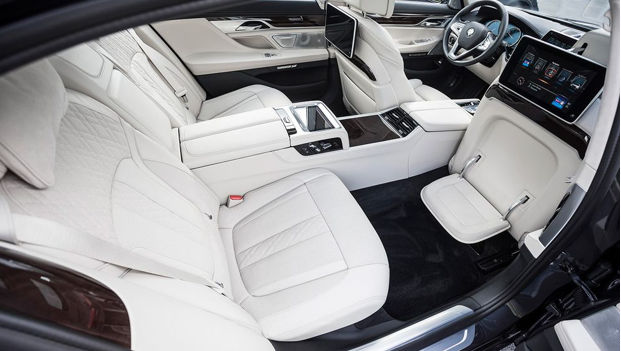 There is a staggering amount of technology that is placed between the driver and the passenger seat in the modern automobile. The technology has gone so far that it now makes or breaks the deal for car buyers and companies alike. We now have infotainment screens bigger than laptops in cars like the Teslas, even in the mid-market brand like Hyundai are pushing for more and more technology inside the cabin for bargainable prices, you can find plenty of options to choose from in the 2020 Hyundai Palisade configuration. However, this was never the case nearly a century ago, the in-cabin entertainment in cars started off with a very rudimentary approach to technology, but it has been a fascinating journey so see AM car radios in the 1930s to the almost cyborg-like car connectivity with the MBUX systems.
There is a staggering amount of technology that is placed between the driver and the passenger seat in the modern automobile. The technology has gone so far that it now makes or breaks the deal for car buyers and companies alike. We now have infotainment screens bigger than laptops in cars like the Teslas, even in the mid-market brand like Hyundai are pushing for more and more technology inside the cabin for bargainable prices, you can find plenty of options to choose from in the 2020 Hyundai Palisade configuration. However, this was never the case nearly a century ago, the in-cabin entertainment in cars started off with a very rudimentary approach to technology, but it has been a fascinating journey so see AM car radios in the 1930s to the almost cyborg-like car connectivity with the MBUX systems.
Definition of an Infotainment System
The car infotainment system is an amalgamation of hardware and software technology which is responsible for delivering both entertainment and information hence the word ‘infotainment’. It can also be described as the interface between the occupants and the car. The infotainment system usually comprises of a touchscreen(s), audio and video interfaces, keypads to interact with them, etc. The modern-day infotainment systems are really versatile, though quite a few of those infotainment systems can also get confusing and can act as a distraction while driving; however, that varies from car to car. Apart from offering a diverse range of conveniences, it also makes the in-vehicle experience livelier by playing music, display rear cameras, hands-free phone connections, and much more.
When did in-Car Infotainment Systems originate?
The origins of the infotainment systems can be traced back as early as the 1930s. this was the time AM radio was introduced in the higher end of the market. The reason why they were only seen in the expensive cars was that they cost you $130, a frightfully large sum of money back then. However, it was not an efficient design, the radios were really clumsy and cumbersome to use.
The evolution of the infotainment system
Just like you see the most premium cars nowadays having cutting-edge technology, but soon trickling down to your everyday 2020 Hyundai Palisade configuration, this similarly has been the case since the start of the car infotainment. At the end of the 1930s, the push-button AM radio trickled down and became a common feature in most cars.
In come the 1950s, more and more people wanted to listen to their own music now in the car, more and more motorists came to expect music players as a standard feature in their car. Manufacturers too worked hard to include these technologies in the cars, make them actually work most of the time, and somehow keep them as affordable as possible. Of course, achieving this was not easy, the technologies were mostly horrible despite all the effort; the audio quality used to get distorted constantly due to the vibrations from the road. In the process, we began to see new and exciting in-vehicle music and radio technologies. The best innovations which we saw in the next 4 decades were 8-track cassettes, in-car record players, car stereos, and in-built MP3 units. 8-track cassettes used to be the most effective, so did the cassette players, though the magnetic tape used to wear out with time.
We saw a huge jump in audio quality with the advent of CD players, they were much lighter and has superior audio quality. They did not fade with time and users were able to carry a lot more CDs than cassettes with them.
Addition of In-Vehicle GPS Navigation
This was inspired by the e-based Global Positioning System (GPS) which was developed in the 1970s by the US Military. However, it took its own sweet time to come to the automobile industry but we finally did see it in Toyota’s 1981 Celica model. This was named NAVICOM, it was controlled by a microcomputer, it continuously displayed graphs on the screen which led the driver to the pre-coded destination. Nearly a decade later in 1990, it was Mazda who came out with the first-ever GPS which people can use.
Infotainment advancements in the new millennium
The technology was a lot similar to the 1990s until the world started its adaptation to smartphones on a massive scale. That affected the in-car technology too, now people wanted more sophistication with full mobile phone integration as well. cars are now getting more and more connected to the customer with concepts like connected technology and IoT.
This infotainment has even trickled to the two-wheeled cousins. Large colored TFT displays are now the norm in many premium and adventure motorcycles. Gone are the days where a needle used to display the speed and RPMs, why have that that when you can use a rectangular screen and potentially get a lot more information; even the sub-500 cc category of motorcycles now has included such systems as a standard feature.
The direction for the next decade primarily seems to be with AI technology, cars are already getting crucial safety features which are monitored consistently through these Ai technologies. Companies like Tesla are pushing autonomous driving while companies like Hyundai are pushing for connected tech and charging points; comparing the 2020 Hyundai Palisade configuration with pricey track-focused cars made by Ferrari and McLaren is ridiculous when you see that some of these quarter-million-dollar cars skip on a lot of infotainment entirely to favor a lighter weight. The roadmap ahead is totally unpredictable but at the same time quite exciting, with reports claiming that the car’s electronics as a percentage of its total cost may rise to about 50% in 2030 up from 35% in 2020 as the automobile industry focuses more and more on the electric vehicle platforms.
Become a Harlem Insider!
By submitting this form, you are consenting to receive marketing emails from: Harlem World Magazine, 2521 1/2 west 42nd street, Los Angeles, CA, 90008, https://www.harlemworldmagazine.com. You can revoke your consent to receive emails at any time by using the SafeUnsubscribe® link, found at the bottom of every email. Emails are serviced by Constant Contact








